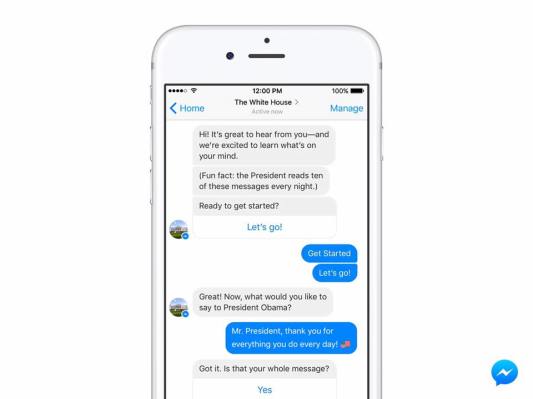Sending a letter to the White House is getting a digital upgrade today. In addition to accepting hand-written missives by postal mail and emails, the public can now send a note to President Obama via Facebook. On the the White House’s Facebook page, you can use Messenger to “speak” to the administration by way of the newly launched White House Messenger bot.
To use the bot, you first click on “Message” on the White House page, then click “Get Started” in the Messenger window that appears. The bot greets you, mentioning also as a “fun fact” that the President reads 10 of these messages every night.
That doesn’t necessarily mean he’s reading 10 Facebook messages, however. As the White House’s Chief Digital Officer Jason Goldman points out in the announcement about the new bot, President Obama reads 10 letters from citizen every night as part of a daily routine designed to keep him in touch with American citizens. This include those sent via postal mail.
The White House has been reading letters from the public since the tradition began with Thomas Jefferson, Goldman notes. But as new technology has emerged, it expanded the way the public can connect. For instance, the White House began taking phone calls in the 1880s, and it introduced a way for people to submit messages online through WhiteHouse.gov in 1994.

After the bot’s initial greeting, it prompts you to click on “Let’s go!” and then asks you what you would like to say to President Obama. From there, you simply write your message in Messenger, just as if you were writing a friend. After you send it, the bot asks if that’s your whole message, to which you can respond “Yes” or “No.” When you click “Yes,” it even gives you a chance to check your typos before the message goes through.
However, to cut down on the spam and other random messages, the bot does ask for your contact information before sending your note, including your U.S. mailing address, email, and phone number. Collecting your personal data like this should help deter people who have threatening messages from using the new system.
“Our goal is to meet people where they are. It’s why the President launched his own Twitter account and the First Lady is on Snapchat,” writes Goldman. “It’s about creating opportunities for people to engage with their government in new and accessible ways, using the same technologies we already rely on in our daily lives.”
The White House’s Messenger bot is the first of its kind for any government, he also adds.
While some of the implementations of Facebook’s Messenger bots have left a lot to be desired in terms of user experience and usefulness, this is one example of the platform’s potential for practical matters. It could also potentially pave the way for other politicians to connect with the public in a similar fashion.
